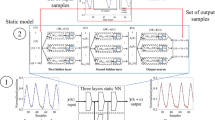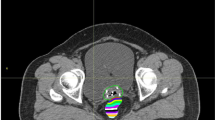Abstract
A neural network for predicting the planning target volume in radiotherapy from the shape of the detected tumor is designed and tested in this research project. The proposed neural network is able to generalize expert medical knowledge and predict the planning target volume from a three-dimensional image of the detected tumor. Initial results for simple shaped brain tumors are presented in this paper.
Similar content being viewed by others
REFERENCES
Lichter, A. S., and Ten-Haken, R. K., Three-dimensional treatment planning and conformal radiation dose delivery. Important. Adv.Onc.95–109, 1995.
Gademann, G., et al., Fractionated stereotactically guided radiotherapy of head and neck tumors: a report on 195 cases. Radiother. Oncol.29:205–213, 1993.
Perez, C. A., et al.Design of a fully integrated three-dimensional computed tomography simulator and preliminary clinical evaluation. Int. J. Radiat. Oncol. Biol. Phys.30:887–897, 1994.
Schlegel, W., et al., Computer systems and mechanical tools for stereotactical guided conformation therapy with linear accelerators. Int. J. Radiat. Oncol. Biol. Phys.24:781–787, 1992.
Ketting, C. H., et al., Consistency of three-dimensional planning target volumes across physicians and institutions. Int. J. Radiat. Oncol. Biol. Phys.37:445–453, 1997.
Leunens, G., et al., Quality assessment of medical decision making in radiation oncology: Variability in target volume delineation for brain tumors. Radiother.Onc.29:169–175, 1993.
Ten-Haken, R. K., et al., A quantitative assessment of the addition of MRI to CT-bases, 3D treatment planning of brain tumors. Radiother. Oncol.25:121–133, 1992.
ICRU Report 50. Prescribing, recording, and reporting photon beam therapy, Bethesda, MD, 1993.
Pendor, M. G., et al.R. Lemke (ed.): Multilayered neural network for the recognition of lung nodules on digital chest radiographs. Proc. CAR 91, Spain 1991.
Willoughby, T. R., et al., Evaluation and scoring of radiotherapy treatment plans using an artificial neural network. Int. Radiation Biol. Phys.34:923–930, 1996.
Lilienblum, T., Albrecht, P., and Michaelis, B., Improvement of 3-D data with neural networks. J. Microelectr. Syst. Integr.5:53–64, 1997.
Bronstein, I. N., and Semendjajew, K. A., Taschenbuch der Mathematik. Teubner Leipzig, 446–448, 1979.
Schad, L. R., et al., Radiotherapy treatment planning of basal meningiomas: improves tumor localization by correlation of CT and MR imaging data. Radiother. Onc.25:56–62, 1992.
Myrianthopoulos, L. C., et al., Quantitation of treatment volumes from CT and MRI in high grade gliomas: Implications for radiotherapy. Magn. Res. Imaging10:375–383, 1992.
Gonzalez, R. C., and Woods, R. E., Digital Image Processing, Addison-Wesley, 1993.
Krell, G., Herzog, A., and Michaelis, B., Real-Time Image Restoration with an Artificial Neural Network. Proc. ICNN'1996, Washington, June 3–6, Vol. 3, pp. 1552–1557, 1996.
Author information
Authors and Affiliations
Rights and permissions
About this article
Cite this article
Kaspari, N., Michaelis, B. & Gademann, G. Using an Artificial Neural Network to Define the Planning Target Volume in Radiotherapy. Journal of Medical Systems 21, 389–401 (1997). https://doi.org/10.1023/A:1022824313552
Issue Date:
DOI: https://doi.org/10.1023/A:1022824313552




